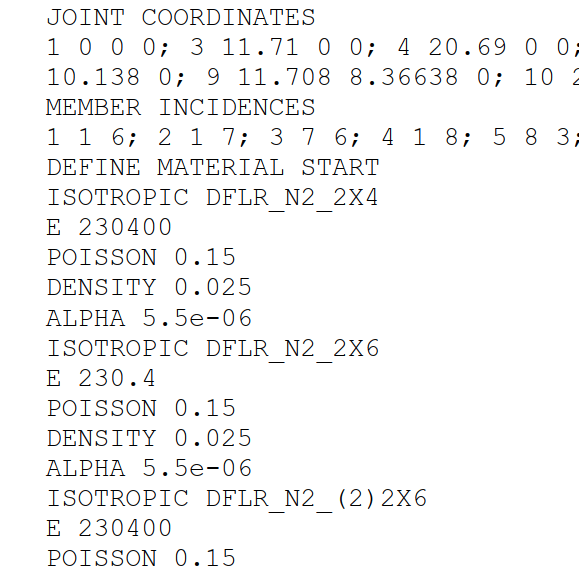WarrenG701
Structural
Hello,
I am having an issue with a truss staad model. It is a simple 2d model of a single span monopitch timber truss supported at either end by bearing walls. The span is 38'-8" and depth is 12'-0". Top and bottom chords are (2) 2x6's, and vertical and diagonal web members are 2x4's. The bottom and top chords are sandwhiching the 2x4 web members. So there is one 2x6 chord on either side of the web members for all web members at both the top and bottom chords. I have provided pictures attached.
My loading is as following. I have applied a nodal point load at the second vertical web member of the truss due to the to the truss supporting a higher roof at this node. Additionally, I have applied a partial uniformly distributed load for the remainder of the truss due to the truss supporting a lower roof. (See the attached dwgs for the cross section of the truss and building/roofs). All of the web members have their ends pinned, so I have released all of the Mx, My, & Mz for all of the web members. The problem is that there is no resulting axial force in any of the web members or top and bottom chords, which of course is not possible. However, the overall deflected shape appears to be as expected.
The two things I am looking for help with are the following:
1)I am not sure if I release the ends of the top and bottom chords because I want to model them as continuous.
2) Why am I not getting any axial forces in any of the web members?
I cannot work out what's wrong. I have also attached the model for anyone who is would like to review it.
I am relatively new to staad so I'm sure it is something simple that I am overlooking. If anyone can offer some advice it would be greatly helpful.
Thanks
-Warren
Photo of Truss Construction:
Photo of High Roof/Low Roof:
Exist. Truss Dwg 1:
Exist. Truss Dwg 2:
STAAD Model:
I am having an issue with a truss staad model. It is a simple 2d model of a single span monopitch timber truss supported at either end by bearing walls. The span is 38'-8" and depth is 12'-0". Top and bottom chords are (2) 2x6's, and vertical and diagonal web members are 2x4's. The bottom and top chords are sandwhiching the 2x4 web members. So there is one 2x6 chord on either side of the web members for all web members at both the top and bottom chords. I have provided pictures attached.
My loading is as following. I have applied a nodal point load at the second vertical web member of the truss due to the to the truss supporting a higher roof at this node. Additionally, I have applied a partial uniformly distributed load for the remainder of the truss due to the truss supporting a lower roof. (See the attached dwgs for the cross section of the truss and building/roofs). All of the web members have their ends pinned, so I have released all of the Mx, My, & Mz for all of the web members. The problem is that there is no resulting axial force in any of the web members or top and bottom chords, which of course is not possible. However, the overall deflected shape appears to be as expected.
The two things I am looking for help with are the following:
1)I am not sure if I release the ends of the top and bottom chords because I want to model them as continuous.
2) Why am I not getting any axial forces in any of the web members?
I cannot work out what's wrong. I have also attached the model for anyone who is would like to review it.
I am relatively new to staad so I'm sure it is something simple that I am overlooking. If anyone can offer some advice it would be greatly helpful.
Thanks
-Warren
Photo of Truss Construction:
Photo of High Roof/Low Roof:
Exist. Truss Dwg 1:
Exist. Truss Dwg 2:
STAAD Model:


![[love] [love] [love]](/data/assets/smilies/love.gif)